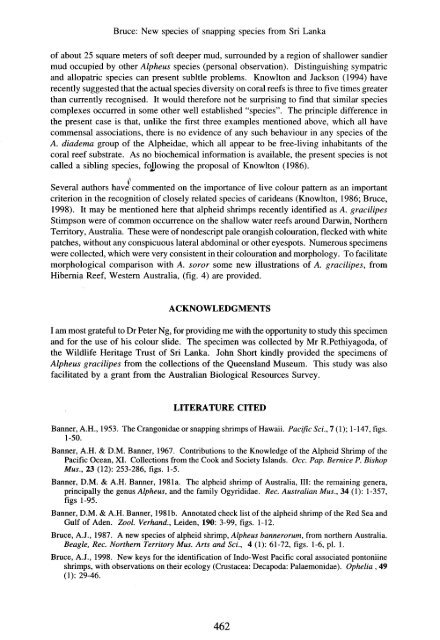alpheus soror, a new snapping shrimp cryptospecies from sri lanka
alpheus soror, a new snapping shrimp cryptospecies from sri lanka
alpheus soror, a new snapping shrimp cryptospecies from sri lanka
Create successful ePaper yourself
Turn your PDF publications into a flip-book with our unique Google optimized e-Paper software.
of about 25 square meters of soft deeper mud, surrounded by a region of shallower sandier<br />
mud occupied by other Alpheus species (personal observation). Distinguishing sympatric<br />
and allopatric species can present subltle problems. Knowlton and Jackson (1994) have<br />
recently suggested that the actual species diversity on coral reefs is three to five times greater<br />
than currently recognised. It would therefore not be surprising to find that similar species<br />
complexes occurred in some other well established "species". The principle difference in<br />
the present case is that, unlike the first three examples mentioned above, which all have<br />
commensal associations, there is no evidence of any such behaviour in any species of the<br />
A. diadema group of the Alpheidae, which all appear to be free-living inhabitants of the<br />
coral reef substrate. As no biochemical information is available, the present species is not<br />
called a sibling species, foj.lowing the proposal of Knowlton (1986).<br />
Several authors havlcommented on the importance of live colour pattern as an important<br />
criterion in the recognition of closely related species of carideans (Knowlton, 1986; Bruce,<br />
1998). It may be mentioned here that alpheid <strong>shrimp</strong>s recently identified as A. gracilipes<br />
Stimpson were of common occurrence on the shallow water reefs around Darwin, Northern<br />
Territory, Australia. These were of nondescript pale orangish colouration, flecked with white<br />
patches, without any conspicuous lateral abdominal or other eyespots. Numerous specimens<br />
were collected, which were very consistent in their colouration and morphology. To facilitate<br />
morphological comparison with A. <strong>soror</strong> some <strong>new</strong> illustrations of A. gracilipes, <strong>from</strong><br />
Hibernia Reef, Western Australia, (fig. 4) are provided.<br />
I am most grateful to Dr Peter Ng, for providing me with the opportunity to study this specimen<br />
and for the use of his colour slide. The specimen was collected by Mr R.Pethiyagoda, of<br />
the Wildlife Heritage Trust of Sri Lanka. John Short kindly provided the specimens of<br />
Alpheus gracilipes <strong>from</strong> the collections of the Queensland Museum. This study was also<br />
facilitated by a grant <strong>from</strong> the Australian Biological Resources Survey.<br />
Banner, AH., 1953. The Crangonidae or <strong>snapping</strong> <strong>shrimp</strong>s of Hawaii. Pacific Sci., 7 (1); 1-147, figs.<br />
1-50.<br />
Banner, AH. & D.M. Banner, 1967. Contributions to the Knowledge of the Alpheid Shrimp of the<br />
Pacific Ocean, XI. Collections <strong>from</strong> the Cook and Society Islands. ace. Pap. Bernice P. Bishop<br />
Mus., 23 (12): 253-286, figs. 1-5.<br />
Banner, D.M. & A.H. Banner, 1981a. The alpheid <strong>shrimp</strong> of Australia, III: the remaining genera,<br />
principally the genus Alpheus, and the family Ogyrididae. Rec. Australian Mus., 34 (1): 1-357,<br />
figs 1-95.<br />
Banner, D.M. & A.H. Banner, 1981b. Annotated check list ofthe alpheid <strong>shrimp</strong> ofthe Red Sea and<br />
Gulf of Aden. Zool. Verhand., Leiden, 190: 3-99, figs. 1-12.<br />
Bruce, A.J., 1987. A <strong>new</strong> species of alpheid <strong>shrimp</strong>, Alpheus bannerorum, <strong>from</strong> northern Australia.<br />
Beagle, Rec. Northern Territory Mus. Arts and Sci., 4 (1): 61-72, figs. 1-6, pI. 1.<br />
Bruce, AJ., 1998. New keys for the identification of Indo-West Pacific coral associated pontoniine<br />
<strong>shrimp</strong>s, with observations on their ecology (Crustacea: Decapoda: Palaemonidae). Ophelia, 49<br />
(1): 29-46.

















